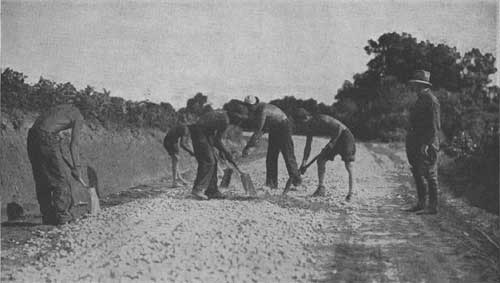|
Taming Our Forests
|

|
THE MEN WHO WORK WITH FORESTS
The time is on the way when we will bring up our forests so well, and the trees will grow so fast and develop lumber at such an early age that year after year after year there will be a perpetual harvest. But whether this will make the men and women of our country happier or more prosperous or secure depends on how we use our crop of trees.
On the men who work with the forests depends the service we get from them. Who are these men and what do they do? How do they get their jobs? What sorts of lives do they lead? What kind of men must they be?
There are certain basic characteristics that the men who work with forests must have whether they are fire fighters hired in an emergency by the ranger, or the Chief of the Forest Service appointed by the Secretary of Agriculture. They must have the proper sort of a body to do the physical work required. They must be strong men. They must be able and willing to stick by their job no matter what it is, and, over and above all, they must have that thing known as character—a certain uprightness of intention—on which other people can count.
The men who do the hand work in the forests—the rank and file who the foresters direct—need these qualities quite as much as the professional foresters themselves. Since the establishment of the C. C. C., most of this work has been done by them. The majority of the 1,000,000 young men who saw service in the C. C. C. during its first 2 years, worked in connection with the forests. Theirs was the actual bone and muscle that put into effect the knowledge of the trained foresters.
If in spite of the dry season of 1935 fewer fires than the average for the 5 years before the C. C. C. was started burned more than 10 acres, it may have been because the C. C. C. built 8,000 miles of new roadways over which the firefighting trucks could be sped in; because they built 35,000 miles of fire lanes and firebreaks and cleared the dead trees and underbrush from 1,038,000 acres; because they took away the in flammable rubbish from 28,000 miles of roadsides where the careless travelers might drop matches; and because they strung 43,000 miles of new telephone lines to connect the lookout towers with the fire stations.

|
| C. C. C. building road. |
This group of young men, who had learned something of forestry and had been trained to work together, saved for the rest of us a vast amount of the things which the forests can give.
They saved it in other ways besides fighting fire. They went out against the white-pine blister rust with poison sprays and with mattock and spade. They pursued the young of the gypsy moth to its cradle and committed a beneficent infanticide upon it over 4 million acres on which it had been undisturbed before. By them 267,000,000 tiny trees were started out in life.
They built bridges over streams and dug ponds for fish; they put check dams across gullies to stop the erosion of the soil and dug irrigation ditches. The list of what they did sounds like Homer's catalog of ships, and the value of it in the inadequate measure of money is over $400,000,000.
But the really important thing that the C. C. C.'s accomplished was to open a new field of public service; to show what could be done to develop our forests by putting in practice the knowledge of the scientists and the trained foresters. It has developed into an efficient understudy of the Forest Service, and with the rapid increase of the educational program in the camps, it may well become a recognized preparation for it.
| <<< Previous | <<< Contents>>> | Next >>> |
|
taming-our-forests/sec11.htm Last Updated: 19-Apr-2010 |